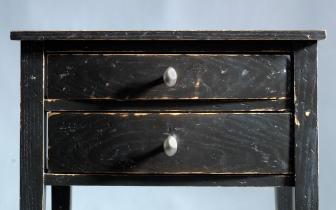Chamfering – Get a wear-aged look with minimal effort.
Chamfering furniture is an incredible way to create the look of wear-aged furniture. It’s a subtle distressing technique that is often overlooked by do-it-yourselfers. Yet it couldn’t be easier. Let’s learn about what chamfering is, and how you can use chamfering to create the look of aged furniture.
What is chamfering?
Chamfering is the process of removing 90 degree edge off a corner by rounding it (unusually to about a 45 degree angle.) If you’re familiar with a beveled edge, you have the right idea in mind. With the right tools chamfering can be accomplished on nearly any material, but for our discussion, we’ll focus on how to create chamfering on wooden furniture. Often, edges are chamfered at the time the piece of furniture is created to give it a finished, sophisticated look. However chamfering is also a way to give a newer piece of furniture the worn appeal of aged furniture.
Creating aged furniture with chamfering
When using chamfering as a way to create wear-aged furniture your aim is to create a piece that looks as though it has aged gently over the years. That means more chamfering is not necessarily better, and uniformity is not your goal. Think of how the piece would have been used over time, and chamfer where the piece would have acquired natural wear.
Chamfering is most effective as a method of creating wear-aged furniture when it is used conservatively and paired with one or more furniture distressing techniques. Here’s an example of how to pair chamfering with another furniture distressing technique. The legs of a farm table are lightly chamfered, and the table finish is distressed with crackle paint.
Tools used to chamfer
There are a number of tools that can chamfer furniture. Let’s discuss a few tools used to create the aged look.
Chamfering plane. A chamfering plane is a unique tool used to create a chamfered or beveled edge. It is most useful to a skilled woodworker when creating handcrafted furniture. It certainly can be used by the average do-it-yourselfer, but it isn’t a tool you’re likely to have on hand, and it takes a bit of practice.
Router with chamfering router bit. A router fitted with a chamfering bit is a fast way to chamfer your furniture. You’ll probably need to finish the piece with same fine grit sandpaper. If you’re skilled with a router, you may just get the results you’re looking for. But if you aren’t, either practice extensively, or choose another chamfering tool.
Palm sander. A palm sander is a power sander that fits in your hand. It will speed the chamfering process but beware; a palm sander may over perform- sanding your piece too aggressively. While you’re likely to have a palm sander in your tool box, use caution when chamfering with it.
File. Chamfering your furniture with a coarse file, then finishing with a fine file is an straightforward way to create the aged furniture look. It is easy to control the intensity of the chamfering, and tools are inexpensive.
Hand sanding block. I’m a believer in using a hand sanding block to create the look of aged furniture. This method is inexpensive, easy to manage, and your likely have a sanding block on hand. Start with a rough grit (lower number) and finish with a fine grit (higher number.)
As you tackle the job of aging your newer furniture using the chamfering technique, I leave you with a few reminders:
- Chamfer where wear would have occurred naturally
- Chamfer conservatively- you can always chamfer more if you feel the piece demands it
- Chamfer in an irregular (“natural”) manner for authenticity
- Chamfer with the grain of the wood when possible
Chamfering is a clever way to create the look of aged furniture and when combined with a strategic sanding over the whole piece can produce very realistic results. I encourage you to learn about other methods of creating the appearance of worn furniture, and pair the two for genuine results.

